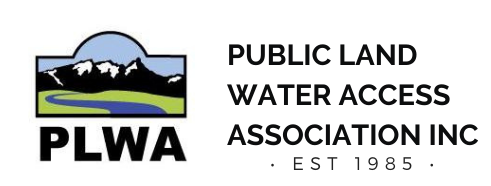Mitchell Slough, Ravalli County, Montana
Mitchell Slough Summary
The 2008 Mitchell Slough Supreme Court case ruling began almost a decade earlier in 1999, when the local Bitterroot Conservation District received an inquiry if a 310 permit, per Montana’s 310 Law (1975 Montana Natural Land and Streambed Preservation Act), was required to do work within the bank and the bed of the trout rich slough. Some of the private landowners had diverted water to a privately owned “ditch” with private trout fishing – not publicly accessible fishing.
The Montana River Action reported, “Mitchell Slough is a historic, 11 miles long side channel of the Bitterroot River and has been used by fishermen and floaters for generations. Known historically as the ‘East Branch’ of Bitterroot River, the waterway has been a favorite fishery for local folks and sustains wild native westslope cutthroat, eastern brook, rainbow, brown trout and whitefish. Bull trout (Dolly Varden) were caught in the past.
Wealthy, out-of-state landowners (rocker Huey Lewis, broker Charles Schwab and others) bought up the land along the slough and other landowners, who cater to paying fishing and private friends, erected double fences to keep out the floaters and waders on the premise that the slough is an irrigation ditch and what was once recognized as public is now theirs. Actually, the slough channels are a natural stream and meander within the riparian area of the Bitterroot River.”
In determining if “natural” applied to the slough, “The BCD unsuccessfully sought intervention from the DNRC, Department of Environmental Quality (DEC) and Fish, Wildlife and Parks (FWP) to determine the status of Mitchell Slough.” The BCD’s determined that Mitchell Slough was not subject to the 310 Law, the authority of which was then challenged by the Bitterroot River Protective Association (BRPA). BRPA also claimed, under Montana’s Stream Access Law, that the waters of the Mitchell Slough were open to recreational access. Through
appeals, the case ended up at the Montana Supreme Court.
In the Amicus Brief filed by the Sportsmen’s Groups, the following groups were represented: Montana Wildlife Federation, Ravalli County Fish and Wildlife Association, Hellgate Hunters and Anglers, Big Sky Upland Bird Association, Helena Hunters and Anglers, Anaconda Sportsmen Inc., Red Lodge Rod and Gun Club, Billings Rod and Gun Club, Dawson Rod and Gun Club, Gallatin Wildlife Association, Russell Country Sportsmen, Skyline Sportsmen Association and the Montana River Action Network.
Their Brief stated, “… all formed for the purpose of promoting and protecting various forms of outdoor recreation. Their concern is not just that the Mitchell might be closed to recreation, but that many streams, creeks, and rivers across Montana may follow suit as well. They are here to speak up for one of the constitutionally protected rights they regularly enjoy.”
Montana Council of Trout Unlimited’s (MTU) Amicus Brief shared, “MTU members were instrumental in passing the Montana Natural Land and Stream bed Preservation Act of 1975 (commonly called ‘the 310 Law’ after its original designation as Senate Bill 310). Over the past two decades MTU and its chapters, working in partnership with private landowners, have undertaken numerous stream restoration projects under the jurisdiction of the 310 Law.”
The Supreme Court reversed the District Court decision, finding that the Mitchell Slough qualified as a natural perennial stream under the 310 Law, requiring a permit to alter the stream bed. The Court determined that Mitchell Slough was a natural channel, improved by people over the years, that the channel existed in a natural state before man-made alterations. “In conclusion, the Mitchell Slough is subject to stream access and public recreation as provided by the SAL. (Stream Access Law)”
Find the case details here.
UPDATE: November 2008
In a unanimous decision of Nov 17, 2008 the Montana Supreme Court decided the Mitchell Slough is open to recreation under the state’s stream access law. The court ruled the 16-mile long slough/side channel roughly followed the century old historic course of a waterway and therefore was subject to public access and permitting like other natural waterways.
For more information see the New York Times and Ravalli Republic articles below.

